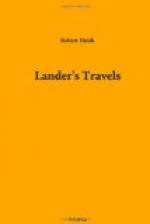The houses are built of rough stones, on each side of the Wady, none are above eight feet in height, receiving their light only through the doors, and their appearance is that of a heap of ruins. The wells are from 100 to 200 feet in depth, the water excellent. During the rains, the valley frequently became flooded by the torrents, and the water has been known to rise so nigh as to hide from view the tallest olive trees in the low grounds. Men and animals are often drowned in the night, before they have time to escape. The torrents from the hill-sides rushing down with such impetuosity, that in an hour or two, the whole country is inundated.
On leaving Benioleed, it was necessary to take a supply of water for three days. The country presented an alternation of stony desert, and plains not incapable of cultivation, but having at this season no water. On the fifth day (6th April), they crossed Wady Zemzem, which runs into the Gulf of Syrtis, and passing over a plain strewed in some parts with cockle-shells, reached the well of Bonjem, which is the northern boundary of Fezzan.
On the 7th April, the camels being loaded with four days’ water, the caravan left Bonjem, and proceeded over a barren desert called Klia. At the end of three hours and a half, they passed a remarkable mound of limestone and sand, resembling, until a very near approach, a white turret. It is called by the natives the Bowl of Bazeen, the latter word signifying an Arab dish, somewhat resembling a hasty pudding. The halt was made at the end of ten hours, in a sandy wady, called Boo-naja, twenty-two miles south-southeast of Bonjem.
The next day, the road led through a defile, called Hormut Em-halla (the pass of the army); then passing a range of table-mountains, running north-east and south-west, called Elood, it crossed a stony and very uneven plain, encircled with mountains, to the pass of Hormut Tazzet. Having cleared the pass, the road opened upon a plain called El Grazat Arab Hoon, where the caravan encamped, after a march of twelve hours and a half. Here one of the camels died; three others were unable to come up, and all of the camels in the coffle were much distressed, not having for several days tasted any kind of food. Two hours and a half further, they came to a solitary tree, which is reckoned a day’s journey from water. Slaves, in coming from the water, are not allowed to drink until they reach the tree, which is one of the longest stages from Fezzan. At the end of nearly eleven hours, the route led through a pass called Hormut Taad Abar, and after wading through a wady, closely hemmed in by mountains, opened into a small circular plain, in which was found a well of brackish, stinking water. In hot seasons, the well is dry, and even at this time it was very low; but the horses sucked up with avidity the mud that was thrown out of it. Still there was not any fodder for the camels, till, about the middle




